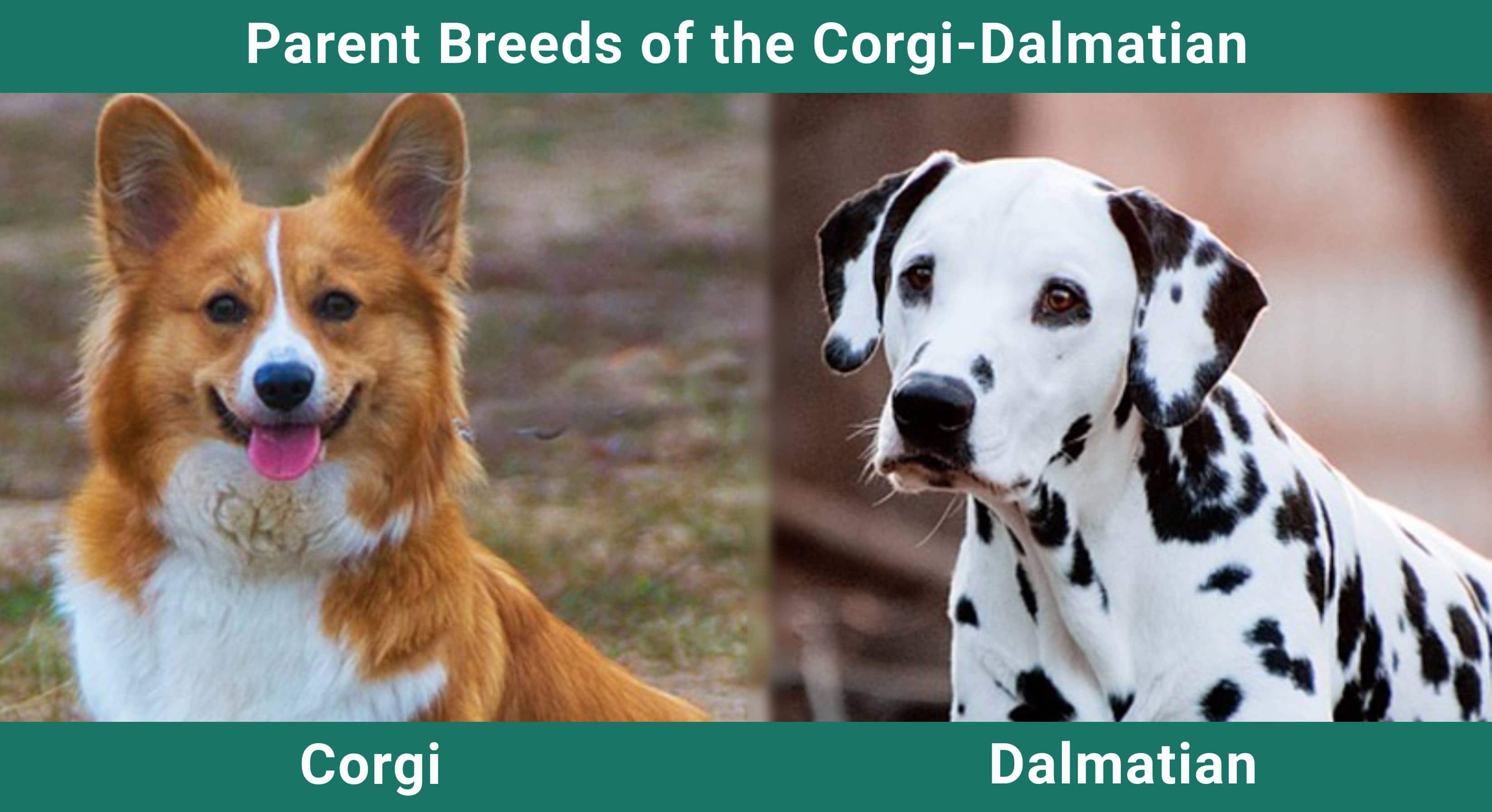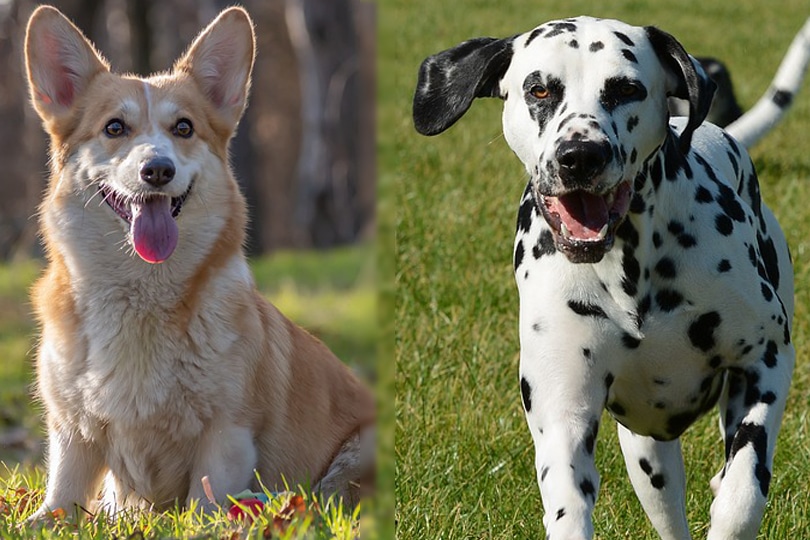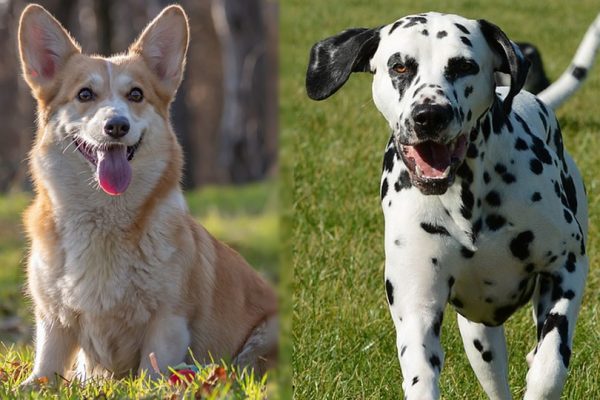Click Below to Skip Ahead
The Corgi Dalmatian is a mix of two popular and well-known breeds: the Dalmatian and either the Pembroke Welsh or the Cardigan Welsh Corgi. Both breeds are active animals and do require regular exercise. They are also smart and intelligent, which is beneficial for training, but can also give rise to a sensitive dog. It is not uncommon for the Corgi Dalmatian hybrid breed to be somewhat shy around strangers, at least for the first meeting or two.
Breed Overview
Height:
10 – 12 inches
Weight:
20 – 50 pounds
Lifespan:
12 – 15 years
Colors:
White, black, brown, fawn
Suitable for:
Active owners willing to spend time with and train their companion
Temperament:
Active, intelligent, smart, sensitive, shy, loyal
The stunted appearance of the Corgi belies the breed’s activity and energy levels, and the Dalmatian was bred as a coach dog and protector, so it too has the energy to burn. While a designer breed like the Corgi Dalmatian can take on the physical and temperamental traits of either parent breed, in the case of those parent breeds that share similar traits, there is a very strong chance that you will see these same traits in the crossbreed. So, whilst your Corgi Dalmatian could have the coat of either parent, it is very likely to have the high exercise requirements of both.
Corgi Dalmatian Puppies
Corgi Dalmatian puppies are hybrid or designer dogs, and not a purebred breed. This does mean that the puppies cost less than a thoroughbred of either parent breed. The cross is not popular as a hybrid, which means that it is not prevalent yet. Although this lack of demand ensures that the price remains low, compared to purebred dogs, it also means that it is not as easy to find a breeder and you may need to travel to find one.
Because it is not purebred, Corgi Dalmatian puppy breeders are not found on the Kennel Club registry. You may be able to find breeders in the hybrid dog registry, and you can search online to find them. There are also Facebook groups, forums, and other online groups dedicated to virtually all breeds, so look around to find one.
Just because the breed is difficult to find does not mean that you should simply opt for the first one you find. Do your diligence and ensure that the breeder has a reasonable reputation and that they rear good puppies from healthy parents. Meet the puppies and ensure that you meet at least the mother dog. Check to ensure that the puppies are bright and attentive and that the dogs are kept in good condition.

Temperament & Intelligence of the Corgi Dalmatian 🧠
The Corgi Dalmatian is a crossbreed. The temperament of the hybrid depends on which of the parent breeds is dominant and which traits it adopts from each parent breed. Generally, though, you should expect an energetic dog that is smart and intelligent but that will benefit from early socialization to help reduce any anxiety around strangers. Read on to see whether the breed has the right temperament for your family.
Are These Dogs Good for Families? 🏡
Both parent breeds can boast of being a companion dog as their secondary job titles. The Corgi is a herder and companion dog, while the Dalmatian was a coach dog and companion. Both breeds are loving and loyal and will form a strong bond with all family members, regardless of age. As such, the Corgi Dalmatian mix can make an excellent addition to any family. It is worth noting that the Corgi, in particular, is a heeler. This means that it nips at the heels of livestock and it may try to do the same to children. Train early to ensure that this isn’t a problem and socialize to ensure that the dog gets along with strangers.
Does This Breed Get Along with Other Pets? 🐶 😽
Neither of the parent breeds was raised to hunt smaller animals, which means that the Corgi Dalmatian should be safe to keep around other animals, including cats and smaller pets. Care should always be taken when introducing dogs to small pets, however. Although neither dog is necessarily a pack dog, they will usually get along with other dogs and may appreciate the companionship.
 Things to Know When Owning a Corgi Dalmatian
Things to Know When Owning a Corgi Dalmatian
The hybrid breed is not that well known, but both parent breeds are popular and a lot is known of their temperament and their requirements. As such, it is possible to determine what your crossbreed will be like.
The Corgi Dalmatian makes a good family dog, can adapt to life in an apartment, and can tolerate being left alone for moderate periods. They are also considered intelligent and eager to please. However, yours may have a stubborn side, will require plenty of exercise, and could be prone to some health conditions like deafness. Read on to see whether it is the right choice of pet for you and your circumstances.
Food & Diet Requirements 🦴
Expect to feed approximately 1.5 cups of dry food per day, but do ensure that you calculate an appropriate amount for your dog. The amount you feed should be determined by the current and target weight of your pooch, as well as how much exercise you provide and its general health. The Corgi, in particular, is prone to putting on weight if fed too much, and your Corgi Dalmatian cross can suffer a similar weight-related fate.
You can also choose to feed wet food, but this does not have as long a shelf life and you can’t leave it down indefinitely. Weigh your dog and check the manufacturer guide to determine how many cans to feed.
Once you have determined how much food to give your dog, split this over two or three meals per day and try to keep to a feeding schedule. If you feed both wet and dry food, typically so that you can provide dry kibble for daily grazing and wet food at meals, take this into account when calculating how much of each to feed.
Exercise 🐕
The Corgi and the Dalmatian have high energy levels, and the hybrid of these two working dogs will require plenty of exercise. The Corgi Dalmatian can live in an apartment, but it will appreciate having some time to play with you and its favorite toys. It would benefit from agility classes and can do very well in a host of other canine sports classes.
At the very least, provide one hour of walks per day, and set aside some time to play.
Training 🦮
The crossbreed is considered intelligent, eager to please its human owners, and also food drive. This combination means that it is also considered easy to train, although the Corgi Dalmatian may occasionally have a stubborn streak that will make it a little more challenging to train.
Because the Corgi is a heeler, it may tend to try and herd animals and young children up, and it may do so by gently nipping at heels. Early training will help prevent this from becoming a problem.
Grooming ✂️
Expect your pup to be a frequent shedder, and provide daily brushing to help minimize the amount of hair that it does shed. Daily brushing helps remove dead hair which will keep the dog comfortable and looking neat.
Nails need trimming, usually every two months, although they may need more frequent trimming if your dog does not walk on concrete and other abrasive surfaces. Start nail clipping when your dog is young to get them used to it and ensure that you do not cut too low or it will cause pain and may cause bleeding.
Another activity that you should start when young is teeth cleaning. This needs to be done at least three times a week to prevent dental decay and painful dental problems.
Health and Conditions ❤️
The Corgi and the Dalmatian are prone to some health problems. In particular, the Corgi can suffer back problems and is prone to putting on too much weight. The Dalmatian is more likely to suffer congenital hearing complaints than other breeds. Look for signs of the following and seek veterinary help if any symptoms do present.
- Allergies
- Back problems
- Eye problems
- Hip dysplasia
- Deafness
Male vs Female
The male Corgi Dalmatian may grow a little larger than the female.
3 Little-Known Facts About the Corgi Dalmatian
1. Corgis Are Skilled Herders
Pembroke Welsh Corgis are believed to have originated from Swedish Vallhunds brought by the Vikings or from Schipperkes and Pomeranians imported by traveling artisans. In either case, the breed came into existence around the 10th Century.
While they might be shorter than the typical working dog, the Corgi is a highly skilled and revered herding dog. They are considered heelers which means that nip at the heels of the cattle to keep them in line and to ensure that they follow directions. The breed was also raised as a companion to the farmers and their families, and today’s Corgi is considered as good a companion dog as a herder.
Although they are now more popular as family dogs than working dogs, Corgis successfully take part in AKC Herding competitions. The Cardigan Corgi is considered a different breed, and there are some obvious differences, it is also a skilled herding dog, so whichever of these is the parent breed to your Corgi Dalmatian, you should expect some herding and heeling attributes.
2. Dalmatians Are Born Without Spots
Dalmatians are best known for their spots. A perfect pattern consists of 3cm spots that are clearly defined, and therefore not clumped together in a single patch. The spots should be evenly distributed, and the spots on the tail and legs should be slightly smaller than those on the main body.
The precise color and pattern of the spots are dictated by the dog’s genes. In particular, it is the piebald gene that causes these unique markings. Piebald genes usually cause patches of color and are also, unfortunately, associated with an increased risk of hereditary deafness and some owners believe that it is those dogs with sparser coverage of spots that have a greater chance of being deaf.
While a Dalmatian is known for its spots, it isn’t born with them. All Dalmatian puppies are born pure white. The spots develop over the first few weeks of the dog’s life, and a puppy will have most of its spots by the time it reaches one month old. Every Dalmatian has a unique combination of spots so no two are the same.
3. Dalmatians Were Originally Bred as Carriage Dogs
The breed has been given several nicknames over time, including Firehouse Dog, because of its widespread use in firehouses across the US. They have been called the Plum Pudding Dog because their coat has a pattern that is similar to that of the spotted pudding.
They have also been nicknamed the English Coach Dog, the Spotted Coach Dog, and the Carriage Dog. These names point to the breed’s original use as a coach dog. It would trot alongside a coach, protecting the horses from wild predators. They would guard the driver and any passengers, too, while also being a companion to the coach workers.
A history of running with coaches and carriages means that the breed retains a high energy drive. It needs plenty of exercise to stay fit and healthy, and the Corgi Dalmatian mix will benefit from regular playtime, agility classes, or taking part in some other form of canine sports classes.
Final Thoughts
The Corgi Dalmatian is a cross between the Corgi and Dalmatian working dogs. The Corgi was raised as a herder and the Dalmatian as a coach dog. Both require plenty of daily exercise, but both make excellent companion pets. This means that you can expect a loyal and loving family dog: one that will especially benefit from an active and energetic family life.
Daily brushing may be required, and the breed is prone to deafness and back problems but is a generally hardy breed. Training is considered easy, thanks to the breed’s intelligence and eagerness to please its owner and the Corgi Dalmatian hybrid usually gets along with people of all ages, as well as dogs and other pets.
See Also:
- American Corgi (Pembroke & Cardigan Corgi Mix): Care Guide, Pictures, Temperament & More
- Cane Corso Dalmatian Mix: Guide, Pictures, Care & More
Featured PhotoCredit: Left – Corgi (ElfinFox, Pixabay), Right – Dalmation (SnottyBoggins, Pixabay)













